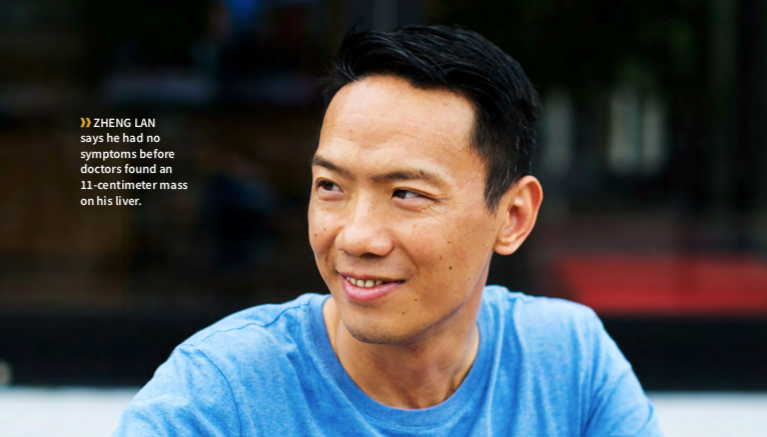Publication
Article
CURE
On the Double: Immunotherapy Combinations in Liver Cancer
Author(s):
As immunotherapies emerge in the treatment of liver cancer, experts examine whether two or more is better than one.
In 2015, Zheng Lan decided he had left his health care on the back burner long enough. The 42-year-old doctor was a research fellow at The University of Texas MD Anderson Cancer Center in Houston, but he hadn’t seen a doctor for himself in years. He let that slip during the hectic years of medical residency.
“I didn’t have any symptoms at the time, but it had been a while since I had seen a primary care doctor, so I decided it was time,” Lan recalls.

He was stunned when an ultrasound found an 11-centimeter mass on his liver. “I panicked,” he says. Lan had liver cancer; specifically, hepatocellular carcinoma.
Further scans at MD Anderson revealed that the cancer had spread to Lan’s lungs. Surgery was not an option. Instead, Lan received radioembolization, which involved delivering tiny beads filled with radioactive material through the hepatic arteries that feed the tumor. The procedure blocks the blood supply (embolization) and delivers radiation to the tumor, largely sparing normal tissue — normal liver cells are fed mostly via the hepatic veins.
The therapy slashed Lan’s alpha-fetoprotein (AFP) levels in half. AFP, though not verified, is a generally used protein tumor marker because it is elevated in 60% to 70% of people with liver cancer.
Lan also received the targeted drug Nexavar (sorafenib), the standard first-line treatment for inoperable liver cancer. Although well tolerated in many people, for Lan, the agent was hell. Besides experiencing hair loss and constant fatigue, the avid runner could barely walk. “The skin on the soles of my feet was peeling off. It was so painful,” he says.
He endured the side effects for a year, during which the cancer continued to grow and spread to one of his kidneys. “I was getting desperate,” he recalls. “I was ready to write a living will. I treated a lot of terminally ill patients and delivered grim messages to their families every day, but this was the first time I felt like I was facing death, and I did not know what to tell my own family.”
Lan had heard that immunotherapy was working wonders in people with metastatic melanoma and that clinical trials were testing its benefits in lung cancer. He wondered if there might be a trial for liver cancer, so he searched online and found out about CheckMate-040. In this study, people would receive the immunotherapy medication Opdivo (nivolumab) alone or with another type of immunotherapy drug, Yervoy (ipilimumab), with or without Cabometyx (cabozantinib), a tyrosine kinase inhibitor that blocks some of the cellular signals that can stimulate cancer cell growth. Researchers would compare the outcomes with those of the control group that would receive Nexavar.
Soon, Lan flew to the University of Southern California to learn whether he was eligible for the trial. In July 2016, he received his first dose of combination Opdivo and Yervoy; the latter was approved at that time by the Food and Drug Administration (FDA) for metastatic melanoma.
“Two weeks after the first dose of the combo, my AFP levels had plummeted,” Lan says. He received four rounds of the combination and then, based on his strong response, switched to a maintenance dose of Opdivo only. Lan, who is now a neuro-critical care fellow at Emory University School of Medicine in Atlanta, continues to take the medication.
In 2017, results from CheckMate-040 led to Opdivo’s distinction as the first immunotherapy drug FDA-approved for liver cancer. Late last year, based on results of the phase 2 KEYNOTE-224 trial, Keytruda (pembrolizumab), another type of immunotherapy, joined its ranks. And in May, Cyramza (ramucirumab), which targets tumor-feeding blood vessels, was approved for the treatment of patients with hepatocellular carcinoma who have an AFP of 400 ng/mL or greater and were previously treated with Nexavar. This approval was based on the REACH-2 trial that showed a median overall survival of 8.5 months for patients who received Cyramza compared with 7.3 months for patients who were given the placebo.
“The REACH-2 data leading to approval of ramuci- rumab for AFP-high advanced HCC represent a probable shift in the field towards a biomarker-defined treatment in this biologically heterogeneous cancer,” says Dr. Katie Kelley, an associate professor of clinical medicine in the department of hematology/oncology at the University of California, San Francisco.
Immunotherapies and targeted medications, including recently approved Cabometyx, bring new options and hope to the patients who do not respond to standard treatment with Nexavar. “Checkpoint inhibitor immunotherapy holds the potential for dramatic and meaningful responses to cancer therapy, and most of the time with very tolerable side effects,” says Kelley. “We are beginning to realize the untapped potential in our immune system.”
LIVER CANCER RISK FACTORS
More than 42,000 people in the United States will receive a liver cancer diagnosis this year.
Hepatocellular carcinoma is the most common type of liver cancer in adults; intrahepatic cholangiocarcinoma, angiosarcoma and hemangiosarcoma are far less common. Liver cancer affects three times as many men as women, and prevalence has tripled in the last 40 years.
Most people, like Lan, don’t have symptoms in the early stages. When signs do arise, the cancer is often more advanced and harder to treat. These symptoms include unintentional weight loss, feeling full after eating only a little, loss of appetite, nausea or vomiting, a mass under the ribs on the left or right (the result of an enlarged spleen or liver), pain in the abdomen or near the right shoulder blade, abdominal swelling, yellowing of the skin or eyes and white, chalky stool.

For people who have chronic hepatitis B or C virus or cirrhosis, known risk factors for liver cancer, symptoms might simply be feeling worse than usual or changes in the results of routine lab tests. “It is essential for people at risk of developing hepatocellular carcinoma, such as those who have hepatitis B or hepatitis C, to be screened regularly with ultrasound and sometimes AFP, though not all entities recommend AFP screening,” says Dr. Ghassan Abou-Alfa, a medical oncologist at Memorial Sloan Kettering Cancer Center in New York City. Other risk factors include diabetes, fatty liver disease, obesity, and tobacco and heavy alcohol use.
Wayne Caswell, a 67-year-old retired dentist in Ridgeland, Mississippi, was shocked when he learned of his diagnosis because, he says, he had no risk factors. In June 2017, Caswell felt what he thought was gallbladder pain. He had a history of gallstones, so Caswell’s doctor recommended that he get checked out before embarking on the first extended vacation of his recent retirement.
“After the ultrasound, the technician — her name was Hope, ironically — said, ‘The doctor wants to do more tests.’ They rushed me back for a CT scan. My AFP was off the charts,” Caswell says. “By the next day, I was diagnosed with terminal stage 4 liver cancer.”
UNLEASHING AN IMMUNE ATTACK
Caswell’s tumor was too large to remove with surgery. In cases like this, patients are typically given liver-directed radiation or chemotherapy and one of two targeted drugs, Nexavar or Lenvima (lenvatinib). Liver-directed chemotherapy, or chemoembolization, is like the radioembolization that Lan received but delivers chemotherapy, rather than radiation, to the tumor while obstructing its blood supply.
Like Lan, Caswell received radioembolization and Nexavar. But the drug made him so sick that he asked if there was any alternative. Fortunately, Opdivo had just gained FDA approval for people who either didn’t respond to Nexavar or didn’t tolerate the side effects well. Caswell got his first infusion of Opdivo in November 2017.
In the first six months, the tumor that once nearly overtook Caswell’s liver shrank from the size of a grapefruit to the size of a lime. Eighteen months and 35 infusions later, his AFP has fallen from 25,000 to 1.8. “I feel wonderful,” Caswell says.
Opdivo and Keytruda are checkpoint inhibitors that target PD-1, a protein found on T cells. Normally, PD-1 serves as an off switch that prevents T cells from attacking other cells in the body. When it attaches to PD-L1, a protein found on cancer cells and some normal cells, it helps the cancer hide, evading an immune attack. Opdivo and Keytruda block the interaction between the two proteins, allowing T cells to recognize the invading cells and unleash an attack. These drugs work in several cancers, such as melanoma and non-small cell lung cancer.
In immunotherapy for liver cancer, the almost 20% of people who respond to the treatment can expect to see their tumors shrink, AFP levels restored to normal or near normal, and, potentially, no progression of disease.
Based on these initial results, Kelley says, “I believe immunotherapy will become a mainstay of therapy for liver cancer, though we need more data to define its role.”
In KEYNOTE-224, 17% of 104 participants responded to Keytruda. One had no detectable disease; for 17 others, their tumors shrank substantially but their cancer did not disappear. Some people developed resistance within three to 16 months, although some patients have had ongoing responses. More than half responded to the drug for a year or longer.
In CheckMate-040, 14.3% of 154 study participants, including people with and without hepatitis, responded to Opdivo. Three had no further evidence of disease and were considered to have had complete responses, whereas 19 still had some disease visible on scans. Resistance developed in some participants within three to 38 months. Of the responders, 91% had responses lasting six months or longer and 55% had responses lasting at least 12 months.
“A subset of patients does so well on immunotherapy alone, and can occasionally have a complete response, that they may not need combination therapy,” Kelley says. “What remains to be seen is whether we can identify them.”
What also remains to be seen is how to achieve responses in the remaining 83%. Combination therapy could be one path. “We know a dramatic response is possible for some on (single immunotherapies),” Kelley says. “My hope is that we will find the right combinations or individualized strategies to help the patients who don’t have that dramatic response on (single medications) achieve it.”
MULTIPLYING THE OPTIONS
Clinical trials are exploring the benefits of these therapeutic alliances. The phase 3 HIMALAYA trial focuses on tremelimumab (which has no brand name yet), an immunotherapy medication that blocks CTLA-4, plus Imfinzi (durvalumab), a PD-L1 checkpoint inhibitor. The trial will compare the combination with Imfinzi alone and Nexavar alone. In the IMBrave150 trial, researchers will compare the duo of PD-L1 checkpoint inhibitor Tecentriq (atezolizumab) and tumor blood vessel-targeting drug Avastin (bevacizumab) with standard Nexavar.
But excitement exists beyond immunotherapy. “There’s a renaissance in oncology research on the liver with multiple new targeted therapies, including the tyrosine kinase inhibitors or multikinase inhibitors, like cabozantinib, that are in later stages of development,” Kelley says.
Early this year, the FDA approved Cabometyx for patients with hepatocellular carcinoma who previously received Nexavar. The decision was based on findings from the phase 3 CELESTIAL trial, which showed that the drug improved overall survival by 2.2 months compared with placebo. “We were very happy to see that this drug showed a sea of evidence of improved survival for patients with liver cancer,” says Abou-Alfa, lead investigator of CELESTIAL.
Other tyrosine kinase inhibitors include Lenvima and Stivarga (regorafenib). Patients who develop resistance to Nexavar can take Stivarga.
Other clinical trials are examining the use of immunotherapy combined with tyrosine kinase inhibitors. For instance, LEAP-002 compares Keytruda with and without Lenvima. COSMIC-312 compares combination Tecentriq and Cabometyx to Nexavar alone.
“Now that we have these effective therapies, it is an incredible opportunity to consider how we might combine liver-directed therapy and immunotherapies to help awaken the immune system,” Kelley says. “We are really just scratching the surface. There is untapped potential for even bigger change on the horizon.”






